The Gibson Explorer was first released in 1958 with a body design that was deemed futuristic at the time. It’s among one the top guitar models in history and is still sought after to this day.
Although initially used for different styles, since the ’80s the Explorer has been a staple of rock music, particularly metal. With an aggressive tone and unique looks, this guitar appeals to shredders who gravitate toward music featuring aggressive distortion.
The Explorer is one of the few guitar body types that’s been copied extensively by many brands. There are plenty of Explorer-type guitars in the market today. Some feature more traditional appointments, while others come with more modern features like active pickups.
With so many options out there, how do you make sense of it all? We’re here to help. Keep reading.
Read more about our review process.
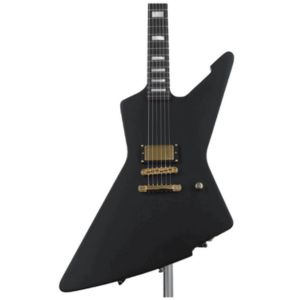
Schecter Cesar Soto E-1
Features: Active EMG pickup, Thin C neck, Tone Pros bridge
Benefits: Great stability, Super fast neck, Searing high gain tones
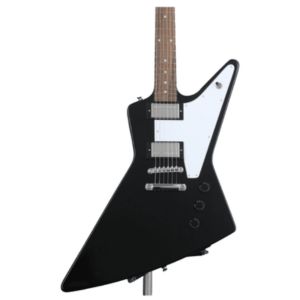
Epiphone Explorer
Features: Mahogany body, Grover tuners, Slimtaper neck
Benefits: Extremely comfortable, Excellent tuning stability, Great fit and finish
Contents
Our Top 3
The Schecter Cesar Soto E-1 Signature is our Top Pick. Built to Ministry’s guitarist’s specifications, it features a mahogany body for extra punchiness and a round yet aggressive tone. With a single humbucker pickup on the bridge, this guitar is made for high distortion music.
The Epiphone Explorer is our Best Budget choice for this list. Authentic features on an affordable model. With a pair of ProBucker pickups, you get the iconic Explorer design and overall features at a fraction of the cost, while retaining the rich midrange character these guitars are known for.
Finally, the Gibson Explorer is our Editor’s Choice. This is the guitar that set the bar for all other Explorer guitars. It’s a great choice for discerning guitarists willing to pay for the superior quality and features of a true classic.
Individual Reviews
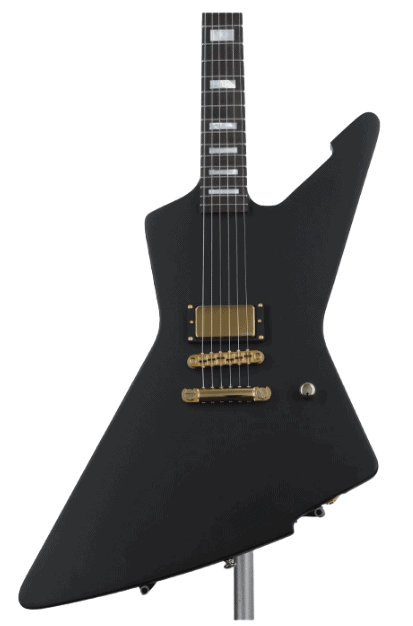
Schecter Cesar Soto E-1 Signature
A fantastic choice for hi-gain tones.
This guitar was built to Ministry's guitarist's strict specifications and is a true metal machine. With an aggressive and in-your-face tone with a menacing look to match, this Schecter is a metal-shredders' dream.
The Schecter Cesar Soto E-1 Signature is a solid-body electric guitar made with a mahogany body to give some roundness to its tone. One look at this instrument, and we knew it was meant for metal, built with a single humbucker pickup on the bridge.
We plugged this Schecter into our Marshall amp and started playing some power chords with high gain. Thanks to the active EMG 85 pickup, we got tons of punch and growl. This guitar’s muscular and aggressive tone is due to the close-aperture coils featured on the single-bridge EMG humbucker.
With Alnico V magnets, this pickup gave us a burning tone with great sustain for single lines and riffs. We liked how it sounded with varying degrees of distortion provided via our Electro Harmonix Big Muff Pi, as well as our Ibanez Tube Screamer. However, the personality of this guitar came through the most with high distortion settings.
The Cesar Soto E-1 gave us a comfortable playing experience on its thin “C” neck curve. This is a very slim 3-piece mahogany neck that allowed us to play fast, which was particularly useful for solos and uptempo passages.
We loved the feel of the 14-inch-radius and the response of the ebony fingerboard across the 22 extra-jumbo frets. Besides great playability, this instrument also gave us fantastic intonation and stability with a TonePros Tune-O-Matic Bridge featuring a T1Z Tailpiece. The Schecter Locking tuners complete the package and make this guitar a great choice for folks who play metal and similar styles.
Verdict: The Schecter Cesar Soto E-1 Signature is a solid-body electric guitar that features a mahogany body and neck, with a single active EMG 85 humbucker on the neck position. With nice playability, this guitar provides an aggressive tone with a nice definition and excels at metal and other hi-distortion genres.
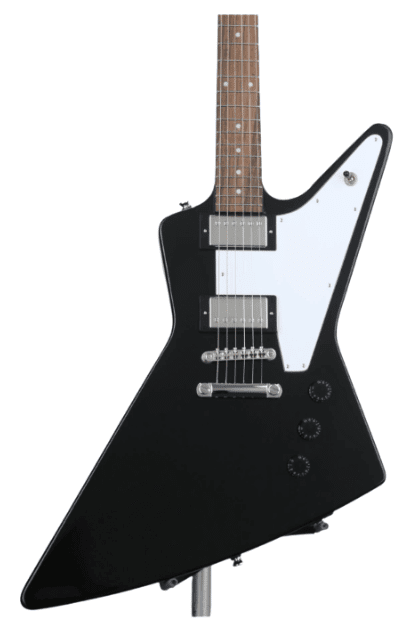
Epiphone Explorer
Authentic features on an affordable model.
Epiphone has been under the Gibson umbrella for years and produces quality instruments at a lower cost. This guitar is the closest you'll get to the real Explorer, but at a truly affordable cost.
The Epiphone Explorer comes with the iconic design that belongs in the pantheon of guitar models, but at a fraction of the cost. We put it through our pedalboard going into our Fender Twin Reverb to discover a rich midrange character and nice sustain that’s aided by this guitar’s mahogany body.
This Epiphone Explorer comes with ProBucker pickups that gave us an authentic PAF-era tone, both in clean and distorted settings. Both the neck and bridge pickups feature Alnico II magnets that help create that vintage PAF humbucker tone. We really liked the defined aggressiveness of the bridge pickup when put through different distortion pedals at high settings.
On the other hand, the neck pickup gave us a richer and warmer tone, and paired well with our Tube Screamer with medium to high distortion. We liked the neck pickup for some tight bottom riffing, as well as rounder leads.
Regarding playability, this Epiphone Explorer was comfortable to play, thanks to its SlimTaper neck profile. We also liked the feel and response of the Indian laurel fingerboard and the sturdiness of its mahogany neck. If you’re a Gibson lover, you’ll truly enjoy the 24.75″ scale length as much as we did. And with a nut width of 1.693″, we got an authentic Gibson feel while playing this Explorer.
In short, a great option for folks who like Explorer-type guitars and want to get close to the real deal, but without spending a fortune.
Verdict: The Epiphone Explorer gives you an authentic PAF humbucker tone with ProBucker pickups on both the neck and bridge positions. With a rich midrange voice and nice sustain, this Explorer gives true Gibson feel and touch at a fraction of the price.
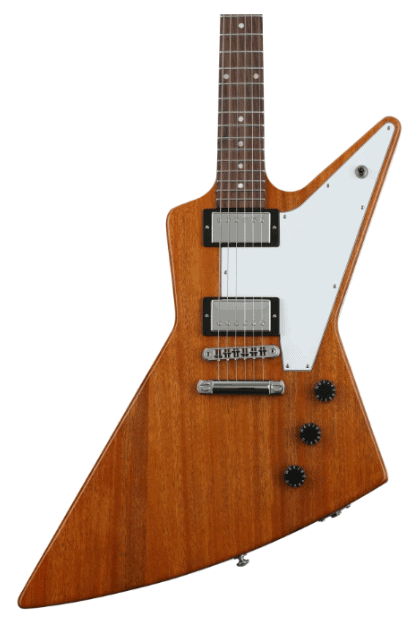
Gibson Explorer
The original Explorer for today's guitar player.
This is the holy grail, the authentic, and the paradigm that defines all other Explorer guitars. If you are a dedicated player that wants the real deal, and who is willing to pay for superior quality, look no further than the Gibson Explorer. A true classic.
The Gibson Explorer has stood the test of time and remains one of the most legendary guitar types that defined an era. We were super excited to try this one and plugged it through our pedalboard into our favorite metal combo amp, the Marshall DSL40CR.
We went straight for the goods and dialed in a distorted tone via our Electro Harmonix Big Muff Pi. This gave us an unmistakable classic Gibson Explorer tone, courtesy of the Burstbucker pickups featured in both the neck and bridge position. We played riff after riff with some leads and double stops while switching from the bridge to the neck pickup and altering the tone knobs.
The whole time through, we got a tight low end and rich midrange, with the bridge pickup giving us a brighter and more aggressive tone. We particularly liked the bridge pickup with the tone knob high for high levels of saturation, especially for riffing. On the other hand, the neck pickup was fantastic for solos that sing, with a balanced and well-defined tone across the entire frequency spectrum. Here, we tried it with different levels of distortion and preferred mid to lower-distortion settings, including overdrive.
Although this guitar excels for distorted tones, it can also handle cleans quite well. We really liked the true PAF humbuckers sound we got at both positions, perfect for strumming clean parts and open chords. So if you want the time-tested tone of a classic Gibson, this Gibson Explorer is the guitar for you.
The playability of this guitar was also great, particularly if you like the Gibson fell. With a rosewood fingerboard on a mahogany neck and a SlimTaper profile, we loved how the Explorer felt and responded. In short, a fantastic instrument for folks who like the Explorer shape and want to go to the original source.
Verdict: The Gibson Explorer is among the most legendary guitar types – and for good reason. It delivers great crunch and overall well-defined tones, with the original Gibson playability and feel. A fantastic option for discerning players who would like to have an Explorer.
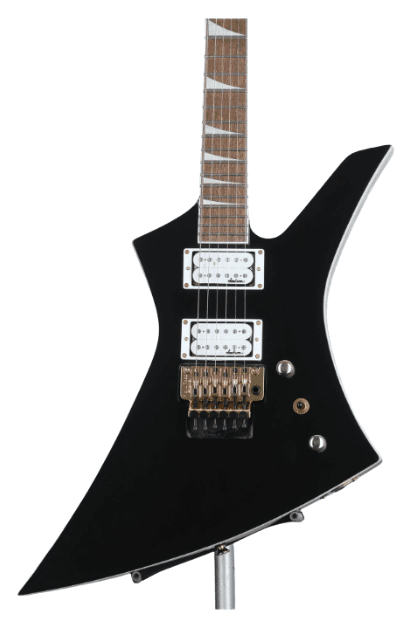
Jackson Kelly KEX
A highly stylized version of a classic body shape.
Jackson has a great reputation as a guitar maker and one that often appeals to shredders and rockers. The Kelly KEX is a modern take on what an Explorer-type guitar is, and comes with features designed for the modern player.
The Jackson Kelly KEX combines the best of a classic design with contemporary design features aimed at modern players. The first thing that stands out here is the two Jackson humbucking pickups. We started our tests plugged into our Marshall combo amp and got a high-output tone from the get-go.
This guitar gave us some muscular tones, particularly in the bridge position when paired with our Electro Harmonix Big Muff Pi. We also got fantastic results when we ran the Kelly KEX through our Tube Screamer, with the neck position giving us tons of growl, but with a more balanced and darker characteristic.
This guitar is made for the modern player, and the 12″-16″ compound-radius fretboard gave us great playability, with a 25.5″ scale length that felt familiar. One of the features that will appeal to shredders is the Floyd Rose vibrato bridge/tailpiece. We got everything from consistent tremolo to dive-bombs that performed well, and will certainly please many metalheads out there.
The Kelly KEX features a poplar body in order to reduce costs, but the drawback is you sacrifice some resonance. That said, this is a good guitar, particularly for beginners who want to play metal.
Verdict: The Jackson Kelly KEX mixes a classic design with contemporary design features, making it a good choice for shredders and metal players. With two Jackson humbucking pickups that deliver high output to a Floyd Rose double-locking vibrato system, this guitar is made for high-distortion genres.
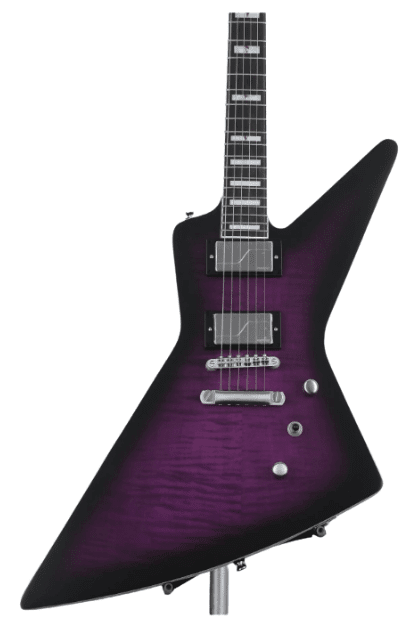
Epiphone Extura Prophecy
A modern version of a classic.
Epiphone ups the ante with the Extura Prophecy by giving the user active pickups that offer fantastic flexibility. With a familiar Gibson feel on the neck, this guitar is great for folks that want to have a killer rock guitar that is a bit more versatile.
The Epiphone Extura Prophecy comes in a lush purple color with black edges and a special touch of aged gloss for a unique look. This color and finish provide a great contrast against the silver hardware, which includes Grover-locking Rotomatic tuners for tuning stability.
Plugged in, this guitar gave us a fat tone that when distorted becomes rich with harmonics with a punchy nature. This is thanks to the featured Fishman Fluence humbucking pickups. Despite its traditional overall look, this guitar includes a push-pull mechanism on both the volume and tone knobs. This allowed us to get three unique, selectable voices from these active pickups.
In our tests, we got everything from vintage humbucker tone to more modern sounds and even a single-coil tone that was devoid of hum. This makes the Extura Prophecy a far more versatile guitar than your typical Explorer, while still remaining affordable.
We particularly liked the aggressive humbucker tone we obtained at the bridge position when we paired this guitar with our Tube Screamer at a relatively high distortion setting. The sound was muscular with tons of growl, ideal for heavy riffing and for leads that cut through any mix.
The asymmetrical SlimTaper neck gave us a nice and comfortable playing experience. We enjoyed the feel of the 12-inch radius and really liked the response of the ebony fingerboard. The 24.724″ scale length gave us a familiar Gibson feel, and we felt that this guitar maintains its tuning and intonation consistently across the 24 jumbo frets.
Verdict: The Epiphone Extura Prophecy features a striking visual push-pull mechanism for more pickup versatility. Outfitted with Fishman Fluence humbucking pickups, this guitar offers you a modernized version of an Explorer guitar, complete with the Gibson feel and playability.
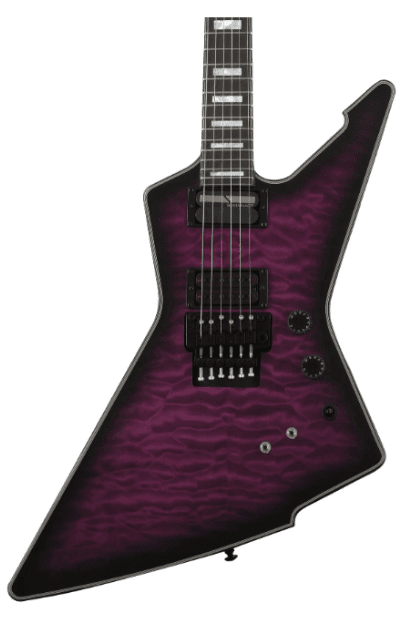
Schecter E-1 FR S Special Edition
An explorer-style guitar made for speed and metal.
Schecter is no stranger to fast shredding and metal, and this guitar is further proof of that. It comes with an innovative neck pickup system, a more traditional choice for the bridge, and fantastic playability as well.
The Schecter E-1 FR S Special Edition comes with features that will benefit fast shredders that delve into high-gain genres. We plugged this guitar into our Marshall combo to first try the Sustainiac humbucker in the neck position. Not only did we get a forward bite with aggressive distortion, but also different levels of sustain.
The Sustainiac pickup comes with a special design feature that allowed us to let notes ring for as long as we wanted. We really liked the 3-way switch design that gives different sustain flavors. We were able to choose between fundamental, mix, and a rich harmonic-type sustain by using the aforementioned switch.
After playing in the neck position for a while, we moved on to the Apocalypse humbucker on the bridge. Here we got a more traditional type of design, as this pickup features Alnico magnets. With a forward and aggressive tone that was rich, the bridge pickup gave us a fantastic option for playing metal. By combining these different pickups, Schecter gave us a versatile Explorer-type guitar with the E-1 FR S Special Edition.
We also liked how fast this guitar’s ebony fingerboard and 3-piece Mahogany set-neck design felt in our hands, with a nice 12″-16″ compound radius for greater comfort. With long sustain and a fast attack, this guitar also features a “C” neck profile with a Fender-like 25.5″ scale length.
The final touch that shredders will love is the Floyd Rose 1500 Series tremolo bridge. This tremolo felt reliable at all times and gave us great stability even when pushed hard for some dive bombs. In short, this guitar is a fantastic choice for folks who like to play fast in metal or similar styles.
Verdict: The Schecter E-1 FR S Special Edition is a good option for fast shredders that gravitate towards metal. With a Sustainiac humbucker in the neck position that gives you three levels of sustain, to an Alnico-based pickup on the bridge, this guitar is a great option for very fast and distorted playing.
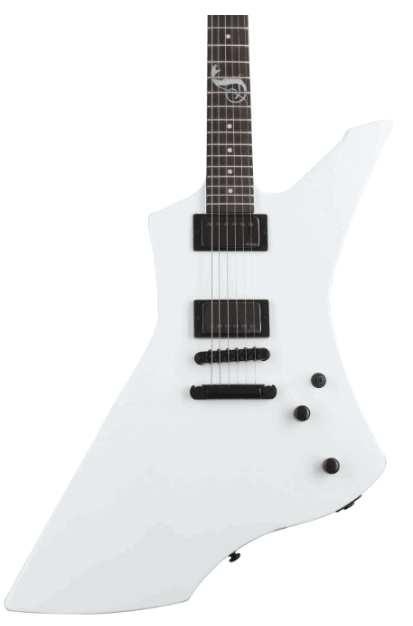
ESP LTD James Hetfield Signature Snakebyte
A metal machine made a true hard-rock legend.
Metallica is an institution in rock, and so ESP LTD paired up with James Hetfield to create a guitar that produces an iconic metal tone. With a set of active pickups that were also designed together, this guitar is great for heavy gain styles.
The ESP LTD James Hetfield Signature Snakebyte gives you the same tone featured in some of metal’s most celebrated recordings. With a set of EMG JH Het Set active pickups, we put this guitar to the test by plugging it into our Marshall combo amp via our pedalboard.
This set of EMG pickups delivers one of the most sought-after tones in metal. With a high output and great note clarity, both of these pickups were designed by EMG along with James Hetfield. Together, they looked for a pair of active humbuckers with the output and clarity of the EMG 85 and 81 pair that the Metallica frontman used for years.
The result came blasting out of our Marshall, and our tone had all the detail, punch, and dynamics that we’d expect from a great set of passive pickups. While the bridge pickup gave us unmatched aggression when paired with our Big Muff Pi, the neck pickup gave us a rounder tone that was also aggressive and rich.
For superior stability, this guitar comes with ESP’s LTD locking tuners and a TonePros locking Tune-O-Matic bridge and tailpiece. During our tests, we felt that this aided the overall intonation and tuning of the instrument, which remained very consistent throughout.
The Snakebyte was also comfortable to play, with a 13.7″ radius that felt just right for fast playing and an Ebony fingerboard that responded nicely to our nuances. In short, a great guitar for metal in the style of Metallica. Folks who want to play other styles, may want to look elsewhere.
Verdict: The ESP LTD James Hetfield Signature Snakebyte comes with a set of EMG JH Het Set active pickups and delivers high output and aggressive tone with great definition. This guitar also offers nice playability, great for fast shredding in metal-like genres.
How to Choose The Right Guitar For You
Explorer guitars are among the most sought-after body types today. Interestingly, this was not always the case. When it was first released, sales were unsuccessful and the model was discontinued in 1963.
After Hamer Guitars saw some success selling similar designs, Gibson decided to reissue the Explorer 1976. It then became popular, particularly among hard rock and heavy metal guitarists.
Today, plenty of brands offer Explorer-type models. Here are a few things to look for when considering one:
Body Shape
The Explorer’s body shape may feel a bit awkward to some. It is a pronounced departure from the typical rounder guitar shapes. It’s important that you play an Explorer-type guitar and experience how the body feels.
It is also not a lightweight guitar. Whether you play sitting down or standing, it may take a bit of getting used to.
Tonewoods
The precise woods used in an Explorer-type guitar will have an unmistakable influence on tone and sustain. This is true for any guitar and Explorers are certainly no exception. We have listed some common choices here.
Mahogany
Unarguably one of the most widespread guitar woods. Although used for guitar bodies as it produces a warm tone with great sustain, it’s a very popular choice for necks and fretboards.
Maple
Next to mahogany, maple is one of the most popular tonewoods. It’s also very sought after for necks and fingerboards, to the point there are raging online debates over mahogany vs maple. Also used for guitar bodies, it produces a bright tone with nice sustain.
Ash
Ash is renowned for delivering a balanced tone with a nice upper midrange. With heavy distortion, you get scooped mids, perfect for metal and other high-gain genres where the Explorer guitar shines.
Alder
Alder is a favored option for guitar bodies because of its light weight and balanced tone. These two traits are great for Explorer-type guitars, as you not only get enhanced tone, but a lighter and more comfortable instrument.
Basswood
Basswood is commonly used for cheaper instruments, but this tonewood also offers some advantages. It is sought after not only for its lower cost, but for producing a warm tone with nice mids.
Poplar
Poplar is a common choice as it helps keep the price of guitars a bit lower. Although it isn’t a bad choice, it doesn’t excel in the sustain department and is mostly used for beginner or budget instruments.
Active vs Passive Pickups
Because Explorer-type guitars are often sought after for metal, many models come with active pickups. These provide a higher output that can also lead to a more aggressive tone.
However, it is important to understand the basic difference between active and passive pickups. Active Pickups need a 9-Volt battery in order to work, typically placed in a compartment on the back of the guitar.
On the other hand, Passive Pickups work without any outside power source and tend to be more versatile. Active pickups are popular because they can provide higher gain tones, hence the preference by many metal and hard rock guitarists.
Final Thoughts
Explorer-type guitars continue to be popular today, despite being released over 60 years ago and enduring low sales at the start. They are commonly used for hard rock and metal, as they offer an aggressive humbucker tone and a unique and angular visual.
There are plenty of models out there, ranging from more traditional to modern options for contemporary players. It’s important that you do your research and try at least a couple of Explorer guitar before picking one.
To recap our choices, The Schecter Cesar Soto E-1 Signature is our Top Pick. Built under Ministry’s guitarist’s specifications, it comes with a mahogany body and aggressive tone thanks to its single humbucker pickup on the bridge.
The Epiphone Explorer is our Best Budget choice and comes with a pair of ProBucker pickups that deliver that rich midrange character on this iconic Explorer design, but at a lower cost.
Finally, the Gibson Explorer is our Editor’s Choice. This is the true classic and the guitar that defines what an Explorer is. This is a fantastic choice for discerning guitarists willing to pay for the superior quality and features of a true classic.


